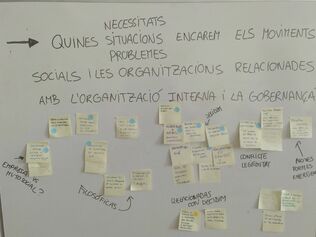LAB Metadecidim - Session 12. Decidim.mov: Technologies for citizen participation for social movements and organizations
July
06
2018
-
Fàbrica de Creació Fabra i Coats
Carrer de Sant Adrià, 20, 08030 Barcelona
Tercera planta, Sala 1
-
12:00 PM - 16:00 PM CEST
Social movements, as well as the associative fabric of organizations and collectives, constitute a space for reflection, experimentation and fundamental action for democracy. The transformative power of social movements has been (and continues to be) a palpable reality in our cities. Donatella Della Porta and Mario Diani analysed how social problems become potential objectives of collective action[1] and offered an interpretation of movements that goes beyond policy change or the replacement of ruling elites: movements are the practical expression of certain social values. Although this vision has made it possible to understand the configuration of many social movements and organizations of the last decades (students, ecologists, animalists, pacifists, etc.), it is insufficient to interpret more recent political expressions, which emerged with the wave of indignation of the last decade. In this generation of movements and organisations, technopolitics (the practice of designing or using technologies to constitute, embody or achieve policy objectives[2]) has become a key element. For this reason, the term "networked social movements" has been proposed to characterize them[3]. These movements make strategic use of digital technologies for collective action[4] which not only offers new channels of communication and action (as proposed by cyberpolitics) but also normative and organizational logics that replicate or draw on the principles and distributed topology of the Internet. Lance Bennett and Alexandra Segerberg have pointed out that networked social movements have meant a shift in logic from "traditional collective action", strongly supported by strong representation and identities, to "connective action", based on direct technologically mediated participation, non-hierarchical organisation and more open forms of identity[5].
As a digital platform for participatory democracy, Decidim[6] draws on the activist experiences of the past decade. Therefore, it is a project with clear inspiration and vocation for a political and technopolitical network[7]. Although many of its first deployments are operated by institutions (the Barcelona City Council being the best known one[8]), its design and many of its functionalities (for example, the assemblies module) try to offer valuable tools for communication, deliberation and decision making by organisations and, by extension, social movements. Decidim is also a project open to the (re)democratic design of its code, which makes it even more adaptable to the needs of these actors.
The purpose of the 12th seminar of the LAB Metadecidim is to evaluate, discuss and imagine the possibilities of Decidim for action, communication and networking of organizations and social movements, highlighting central aspects such as free software, technological autonomy or data privacy in the era of corporate social networks and mass surveillance. The future of Decidim must be based on collaborative development and continuous dialogue with organizations and movements, in order to bring their common goal: social transformation closer.
--------------------------------------------------------------------------
- Della Porta, D., & Diani, M. (2011). Los movimientos sociales (Vol. 4). CIS.
- Hecht, G. (2009). The radiance of France: Nuclear power and national identity after World War II. MIT press.
- Juris, J. S. (2004). Networked social movements: global movements for global justice, en Castells., M. (ed.) The network society: a cross-cultural perspective, pp. 341-362. Cheltenham, UK: Edward Elgar.
- Bennett, W. L., & Segerberg, A. (2012). The logic of connective action: Digital media and the personalization of contentious politics. Information, Communication & Society, 15(5), 739-768.
- Alcazan, A., Axebra, Q., Levi, S., SuNotissima, T., & Toret, J. (2012). Tecnopolítica Internet y R-evoluciones. Sobre la centralidad de las redes digitales en el 15M.
- https://www.decidim.org
- Barandiaran, X., Calleja-López, A., Monterde, A., Aragón, P., Linares, J., Romero, C., & Pereira, A. (2017). Decidim: redes políticas y tecnopolíticas para la democracia participativa. Recerca: revista de pensament i anàlisi, (21), 137-150.
- https://www.decidim.barcelona
Challenge:
To make Decidim a tool capable of supporting and strengthening the practices of organizations and social movements sensitive to the strategic use of digital technologies for collective organization and action.
Questions:
- What functionalities or aspects of Decidim are useful for meeting internal needs and achieving the objectives of organizations and social movements?
- What needs of organizations and social movements are not covered by the current (or developing) functionalities of Decidim?
- How could Decidim strengthen the connection between the digital and the presential in order to promote multiple, more accessible and effective forms of collective action?
- What other free digital tools are of interest in the context of social movements and should be integrated into Decidim?
- What are the limits of digital participation in movements and how can Decidim be used to overcome these limits?
Program
Presentation of the challenge by the team of Metadecidim Lab [12:00 - 12:10]
Presentations [12:10 - 13:00]
- Margarita Padilla, Dabne
- Marc Pradel, Universitat de Barcelona
- Jordi Mir Garcia, Universitat Pompeu Fabra
Debate with the "zero line" [13:00 - 13:30]
- Yaiza Blanch, Som Energia
- Xavi Palos, Xarxa d'Economia Solidària de Catalunya
- Lidón Gasull, Federació d'Associacions de Mares i Pares d'Alumnes de Catalunya
- Mercè Botella, Som Connexió
- Carles Viñas, Consell d'Associacions de Barcelona
- Franchi, Sobtec







Share
Or copy link